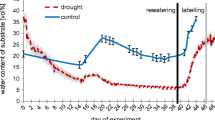Summary
Qualitative and quantitative aspects of heterotrophic carbon assimilation by mycorrhizal plants of birch (Betula pendula) were examined. Plants were grown aseptically from seed in the mycorrhizal condition with the fungus Hebeloma crustuliniforme and in the non-mycorrhizal condition, with protein as their sole exogenous nitrogen source. Yields and nitrogen contents were determined in some of the plants, while the roots of others were supplied with 14C-labelled protein and their shoots exposed for up to 72 h to different irradiance regimes. Only mycorrhizal plants utilised the organic nitrogen. Uptake of carbon associated with this utilisation and its translocation to the leaves was demonstrated directly by means of autoradiography. Amounts of activity transferred to shoots were greatest in low irradiance regimes. Calculation of net carbon gain from the heterotrophic source, based upon the assumption that breakdown products of protein are assimilated as amino-acids, indicates that over a 55-day growth period up to 9% of plant C may be derived from protein. The physiological and ecological significance of these findings are discussed.
Similar content being viewed by others
References
Abuarghub SM, Read DJ (1988a) The biology of mycorrhiza in the Ericaceae XI. The distribution of nitrogen in soil of a typical upland Callunetum with special reference to the “free” amino acids. New Phytol 108: 425–431
Abuarghub SM, Read DJ (1988b) The biology of mycorrhiza in the Ericaceae XII. Quantitative analysis of individual “free” amino acids in relation to time and depth in the soil profile. New Phytol 108: 433–441
Abuzinadah RA, Read DJ (1986a) The role of proteins in the nitrogen nutrition of ectomycorrhizal plants: I. Utilization of peptides and proteins by ectomycorrhizal fungi. New Phytol 103: 481–494
Abuzinadah RA, Read DJ (1986b) The role of proteins in the nitrogen nutrition of ectomycorrhizal plants: III. Protein utilization by Betula, Picea and Pinus in mycorrhizal association with Hebeloma crustuliniforme. New Phytol 103: 507–514
Abuzinadah RA, Read DJ (1988) Amino acids as nitrogen sources for ectomycorrhizal fungi. Trans Br Mycol Soc 91: 473–479
Abuzinadah RA, Finlay R, Read DJ (1986) The role of proteins in the nitrogen nutrition of ectomycorrhizal plants: II. Utilization of protein by mycorrhizal plants of Pinus contorta. New Phytol 103: 495–506
Carrodus BB (1966) Absorption of nitrogen by mycorrhizal roots of beech: I. Factors affecting the assimilation of nitrogen. New Phytol 65: 358–371
Clarkson DT (1985) Factors affecting mineral nutrient acquisition by plants. Annu Rev Plant Physiol 36: 77–115
Fitter AH, Hay RKM (1987) Environmental physiology of plants. Academic Press, London
France RC, Reid CPP (1983) Interactions of nitrogen and carbon in the physiology of ectomycorrhiza. Can J Bot 61: 964–984
Frank AB (1894) Die Bedeutung der Mykorrhiza-Pilze für die gemeine Kiefer. Forst Zentralbl 16: 1852–1890
Harley JL (1973) Symbiosis in the ecosystem. J Nat Sci Council Sri Lanka 1: 31–48
Harley JL (1978) Ectomycorrhizas as nutrient absorbing organs. Proc R Soc London [B] 203: 1–21
Hutchinson TC (1967) Comparative studies of the ability of species to withstand prolonged periods of darkness. J Ecol 55: 291–299
Laiho O (1970) Paxillus involutus as a mycorrhizal symbiont of forest trees. Acta For Fenn 79: 1–35
Lewis DH (1976) Interchange of metabolites in biotrophic symbioses between angiosperms and fungi. In: Sutherland N (ed) Perspectives in experimental biology; vol 2. Botany. Pergamon Press, Oxford, pp 207–219
MacDougal DT, Dufrenoy J (1946) Criteria of nutritive relations of fungi and seed plants in mycorrhizae. Plant Physiol 21: 1–10
Martin F, Stewart GR, Genetet I, Le Tacon F (1986) Assimilation of 15NH4+ by beech (Fagus sylvatica L.) ectomycorrhizas. New Phytol 102: 85–94
Martin F, Ramstedt M, Söderhall K (1987) Carbon and nitrogen metabolism in ectomycorrhizal fungi and ectomycorrhizas. Biochemie 69: 569–581
McRee KJ, Troughton JH (1966) Prediction of growth rate at different light levels from measured photosynthesis and respiration rates. Plant Physiol 41: 559–566
Melin E (1925) Untersuchungen über die Bedeutung der Baummykorrhize. Fischer, Jena
Melin E, Nilsson H (1953) Transfer of labelled nitrogen from glutamic acid to pine seedlings through the mycelium of Boletus variegatus (Sw.) Fr. Nature 171: 134
Oaks A, Hirel B (1985) Nitrogen metabolism in roots. Annu Rev Plant Physiol 36: 345–365
Pate J (1986) Economy of symbiotic nitrogen function. In: Givnish TJ (ed) On the economy of plant form and function. Cambridge University Press, Cambridge, pp 299–325
Read DJ, Leake JR, Langdale AR (1989) The nitrogen nutrition of mycorrhizal fungi and their host plants. In: Boddy L, Marchant R, Read DJ (eds) Physiology and ecology of nitrogen, phosphorus and sulphur utilisation by fungi. British Mycological Society Symposium, vol 14, pp 181–204
Sangwanit V, Bledsoe CS (1987) Mycorrhizal fungi enchance uptake and storage of amino acids in mycorrhizal Douglas-Fir and western hemlock seedlings. In: Sylvia DM, Hung LL, Graham JH (eds) Mycorrhizae in the next decade. Proceedings of the 7th North American Conference on Mycorrhizae, Gainesville, Florida, p 262
Young HE (1947) Carbohydrate absorption by the roots of Pinus taeda. Queensland J Agric Sci 4: 1–6
Author information
Authors and Affiliations
Rights and permissions
About this article
Cite this article
Abuzinadah, R.A., Read, D.J. Carbon transfer associated with assimilation of organic nitrogen sources by silver birch (Betula pendula Roth.). Trees 3, 17–23 (1989). https://doi.org/10.1007/BF00202396
Received:
Issue Date:
DOI: https://doi.org/10.1007/BF00202396




